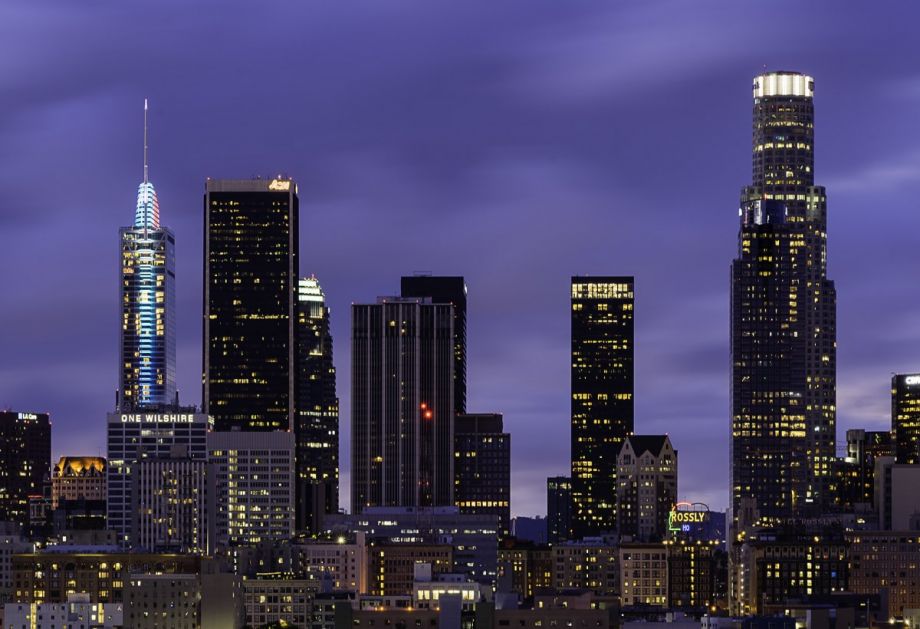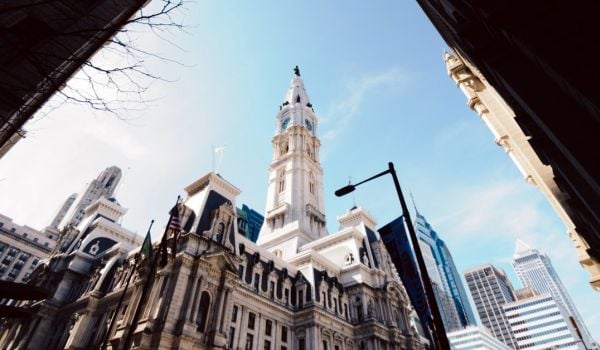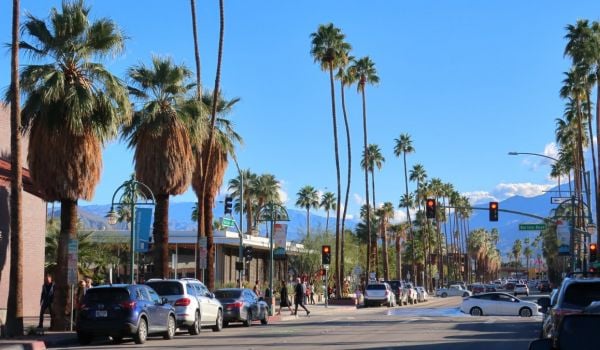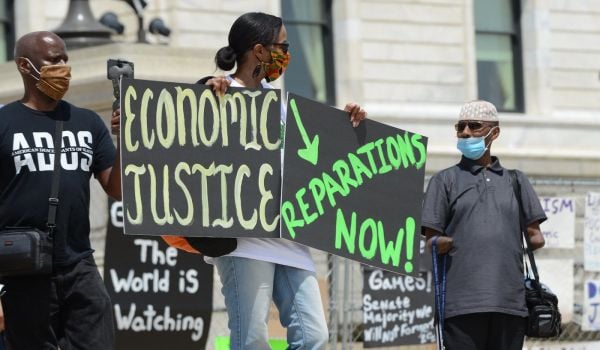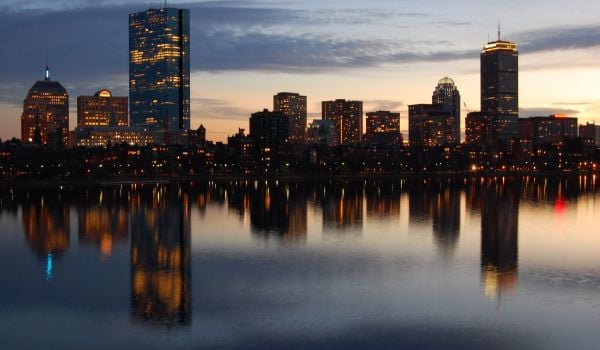Prince Osemwengie has been looking into every tool in the toolbox to help stem the tide of local businesses being displaced due to rising rents and rising property values in South Los Angeles: Technical assistance and legal aid for small business owners, commercial rent subsidies, tax credits for small business oriented economic development, community ownership of commercial real estate, and all the above.
But with the financial system so tilted against local businesses, especially Black- and Brown-owned businesses, he believes the time has come for a more drastic solution: L.A.’s first city-owned bank. And with a recent city council vote, that solution is one step closer.
Osemwengie is a policy associate at Inclusive Action for the City, a nonprofit that provides support to street vendors and other micro-entrepreneurs across South L.A. In interviews with small businesses and developers, he’s heard that these businesses would love to acquire the commercial properties they’ve been renting in the commercial corridors or hubs they’ve served for years. But existing tools like the Small Business Administration’s various loan guarantee programs have requirements that keep them out — even though the programs are advertised to help those who wouldn’t otherwise qualify for small business loans.
That’s why Inclusive Action for the City is also part of the grassroots coalition calling for the creation of a city-owned wholesale bank, tentatively named the Municipal Bank of Los Angeles. Last week, Los Angeles City Council voted unanimously to move ahead with the next step toward creating such a bank – a move that could shift the whole local financial landscape in favor of the street vendors and minority business owners Osemwengie has been supporting.
As a wholesale bank, the Municipal Bank of Los Angeles wouldn’t raise deposits from people or private businesses or make loans directly to them. Instead, it would hold deposits from the city government or maybe also local anchor institutions like hospitals, universities, transit agencies and port authorities. Its lending would flow through other financial institutions — like Inclusive Action for the City — to support more loans on more favorable terms for borrowers or projects that typically can’t get access to responsible, non-predatory loans.
It’s a model that takes lessons from other sectors like housing, where public or quasi-public financial institutions like Fannie Mae and Freddie Mac work through private lenders to support residential lending.
“Right now the city could deposit $400 million in Bank of America, but there’s no say on what Bank of America does with those deposits,” Osemwengie says. “So they could be funding gas and oil because it has a higher return. Whereas with a [Municipal Bank of Los Angeles] it could be a case where that money is only invested into our communities or carbon neutral industry or green infrastructure or something of that nature.”
Los Angeles is one of several cities and states across the county where organizers have been pushing for the creation of government-owned banks, also known as public banks. But there’s more than one model proposed for a public bank. Some want a public option for consumers and businesses locked out of other banking and credit options to open up free checking accounts or access low-cost, non-predatory loans. That’s not what is being proposed for Los Angeles, or anywhere else in California.
The local governments of Oakland, Berkeley and Richmond have endorsed a plan for a jointly-owned wholesale bank serving their jurisdictions. Meanwhile, San Francisco’s Board of Supervisors appointed a commission last year that worked with consultants to draft a business plan for a similar city-owned wholesale bank, released for public comment earlier this year. Los Angeles City Council voted last week to approve funding for a contract with consultants to do the same.
Across the country, organizers in New York also want to create a city-owned wholesale bank — as well as in Philadelphia, where city council voted last year to create the Philadelphia Public Financial Authority as a first step toward creating one. A growing number of state and local governments have also created or are considering creating “green banks,” which are wholesale financial institutions that specialize in supporting loans for renewable energy, electric vehicles, heat pumps or other planet-saving investments.
Right now the only place across the country that has a government-owned wholesale bank comparable to the one being proposed for L.A., San Francisco, New York City or Philadelphia is North Dakota, where the state-owned Bank of North Dakota has been around since 1919. It operates as a wholesale bank, holding all of the state government’s deposits while supporting loans through local lenders to support farming, economic development and small businesses across the state. In a typical year, the Bank of North Dakota supports around 300 loans for agriculture and 500 loans to businesses, all loans originated by local banks and credit unions across the state. Through its business model, the Bank of North Dakota itself doesn’t cost the state a dime — actually, it often returns some of the profits it makes back to the state government.
In part because there’s only one example across the entire country, and it’s in such a relatively remote location, organizers in other places continue to battle against the inertia of introducing the idea of a wholesale public bank, as well as misperceptions or misunderstandings of how it could work.
“There’s still a big misunderstanding of what exactly this proposed public bank is,” Osemwengie says. “It’s not going to be a consumer bank or retail bank, meaning it cannot directly lend to me or you or directly lend to small businesses. Off the bat, that’s a misunderstanding overall among a lot of people, even some community advocates.”
Creating a vision
Help has recently arrived. A new report series produced by two think tanks lays out both the potential structure and the potential impact of a hypothetical Municipal Bank of Los Angeles.
The New York-based Jain Family Institute and L.A.-based Berggruen Institute first reached out to the organizers at Public Bank Los Angeles about a year ago about producing a joint report series. Some of the organizers have been rallying around the idea for more than a decade, originally as part of other movements like Occupy Wall Street or environmental activism against big banks continuing to invest public deposits in the fossil fuel industry.
A year ago, Public Bank Los Angeles was beginning to draft a hypothetical business plan for a Municipal Bank of Los Angeles. They shared what they had outlined so far with the two think tanks, who took that as a starting point and fleshed it out into a five-part series of reports. The series includes an interactive tool allowing users to simulate a hypothetical loan portfolio for a Municipal Bank of Los Angeles and see how the dollars invested translate into outcomes like affordable housing units financed, worker-owners created, or megawatt hours of renewable energy produced.
“They went above and beyond our expectations in providing a roadmap for the establishment and some of the operational elements of an L.A. public bank,” says Trinity Tran, Public Bank LA co-founder and lead organizer. “These reports really will help set the stage and shape the boundaries of acceptable discourse and drive the vision for some of the policies and the framework of the L.A. public bank. It was important to be able to frame this as doable.”
Overall, the hypothetical Municipal Bank of Los Angeles envisioned in the series would work across three sectors: housing, small business and renewable energy. For each sector, the series includes a report detailing multiple lines of business, each with average loan sizes, interest rates charged and annual lending volumes.
The housing report outlines low-cost debt for construction, an acquisition loan fund for affordable housing preservation, and expanding low to moderate-income homebuyer assistance. The small business report focuses on loans to support worker-ownership conversions of existing businesses. The renewable energy report includes loans to support community solar projects as well as financing products that would help power utilities unlock the unprecedented federal funding for renewable made available through the Inflation Reduction Act.
The total portfolio of the hypothetical Municipal Bank of Los Angeles in its first year would be $952 million, and the report series projects the first ten years of growth for the bank. The projections include different scenarios emphasizing each of the different lending areas. A focus on housing leads to slightly faster growth for the bank compared to focusing on small business or renewable energy. In a default sample scenario, the bank would help finance an average of 1,700 affordable housing units, 140 new worker-owners and 2.9 million green megawatt hours of energy production per year.
But the key to the whole thing is using the relative largesse of a Municipal Bank of Los Angeles to influence other lenders working in the city to partner with the bank and expand their range of lending activity across all three areas. Some lenders are already willing, like Inclusive Action for the City. Other lenders likely won’t be interested until the Municipal Bank of Los Angeles can attract them into these lending areas the way Fannie Mae and Freddie Mac drive capital into the mortgage market.
Before Fannie Mae’s creation in 1938, few lenders would make 30-year fixed rate mortgages with relatively low down payments, but today those mortgage terms are a fixture of the housing market. The two entities now support the majority of residential mortgages originated every year by private lenders. Similarly, the co-authors of the report series believe a city-owned wholesale bank could serve as a standby partner for lenders along its various lines of business — like a much smaller, local Fannie Mae that supports more than just residential lending.
The presence of a public bank would help attract or “crowd-in” a critical mass of lenders who may or may not have a radical social mission at heart but simply see the benefit to their bottom line of partnering on these deals with the Municipal Bank of Los Angeles. “I often use the phrase ‘like bees to honey,’” says Alison Lingane, who co-authored the small business report in the series.
As she envisions it, the Municipal Bank of Los Angeles could help ensure there are not just one or two but a handful or more lenders always around and standing ready to finance worker-ownership conversions because they can do it with a loan guarantee or some other structured product offered by the Municipal Bank of Los Angeles. In her other capacity as co-founder of Project Equity, Lingane has been supporting worker-ownership transitions, such as the conversion of L.A.’s beloved Proof Bakery into a worker-owned cooperative. But too often, Lingane says, there’s some understandable hesitation on the part of existing owners to go through the worker-ownership conversion process. Even if the owner has a healthy relationship with their workers, it’s not always clear there will be sufficient capital on the workers’ side to buy the business from the owner.
“It can really help to accelerate more of these transitions if we have a pool of capital focused on the L.A. market to do it,” Lingane says.
Commercial real estate lending isn’t mentioned in the report series explicitly, but community development financial institutions (CDFIs) are. As a CDFI, Inclusive Action for the City could borrow flexible, low-cost capital from the Municipal Bank of Los Angeles, which it could use to support entrepreneurs by financing their acquisition of commercial spaces for their businesses.
Although CDFIs can access other large private funders like banks or foundations, supporters of a public bank argue that the public’s wealth, including the significant pools of deposits held by state or local government, should exclusively support investments in public priorities like affordable housing, clean energy and building wealth for workers through worker-ownership.
“A public bank could also help infuse capital into the CDFI industry out here, which ultimately helps us better serve businesses,” Osemwengie says.
This article is part of The Bottom Line, a series exploring scalable solutions for problems related to affordability, inclusive economic growth and access to capital. Click here to subscribe to our Bottom Line newsletter.

Oscar is Next City's senior economic justice correspondent. He previously served as Next City’s editor from 2018-2019, and was a Next City Equitable Cities Fellow from 2015-2016. Since 2011, Oscar has covered community development finance, community banking, impact investing, economic development, housing and more for media outlets such as Shelterforce, B Magazine, Impact Alpha and Fast Company.
Follow Oscar .(JavaScript must be enabled to view this email address)



